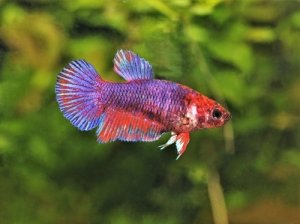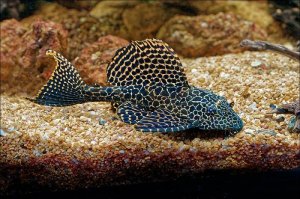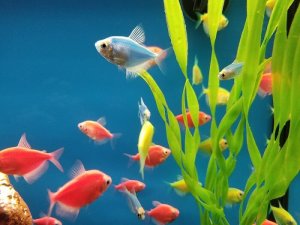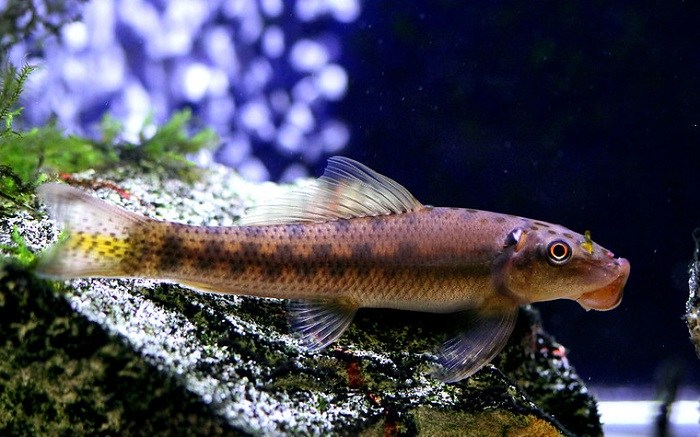
If you love the idea of including an algae-eating fish to keep your tank clean but you want something other than the more common Pleco family or Cory Catfish, you may consider the Chinese Algae Eater. However, after reading about their reputation, many fish keepers find themselves asking ‘Is the Chinese Algae Eater aggressive?’ and wondering how it will get on in a community tank.
There are many myths about these fish, including misinformation about Chinese Algae Eater size, that can put aquarists off buying them. However, when you are informed, you will find it is easy to take care of them, so read on to find out how.
Breed Overview
| Origin | Southeast Asia |
| Lifespan | Up to 15 years (if well cared for) |
| Size | Up to 12 inches or 30 cm |
| Colors | Mottled greenish brown |
| Water Type | Freshwater |
| Tank Size | Minimum 55 gallons |
| Temperament | Solitary and curious, but can be aggressive in wrong conditions |
| Water Temperature | 24-28 C 74-82 F |
| Water pH | Neutral |
| Food | Omnivores (despite what their name will suggest) |
Appearance
The Chinese Algae Eater may not be brightly colored, but it is a remarkable and very interesting fish that is perfectly camouflaged. In fact, if you keep it in the right environment, you will see how expertly these fish blend into their surroundings.
1. Body Shape And Color
Unlike some Algae Eaters, they have a relatively slender body. However, one of the major characteristics they share with other Algae Eaters is a slightly rounded head due to the placement and formation of their sucker mouth.
Color-wise, they are often a light mottled greenish brown with bands of dark brown ranging to black or brownish grey on their bodies. In general, this coloring helps camouflage them in their natural habitats.
- Chinese Algae Eater Size- One of the biggest mistakes people make when looking after this fish is not realizing that it can grow up to 12 inches or 30 cm! As a result, even if your tank is technically large enough, it may be that your fish gets so big that territorial disputes break out.
2. Color Morphs
Like with many aquarium fish, a variety of color morphs are available. The most common alternative is gold, but be very careful. Often when you see these fish, they have more likely than not been injected with die.
This causes health problems in the fish and is not something that is recommended in any way for aquarists who care about their fish’s wellbeing. So, steer clear of these fish. There are other morphs such as the albino and leucistic morphs that come from simple genetic mutations and do not result in fish that are in pain.
Author’s Note: It is very difficult to tell the males from the females in this species. This is another reason why they are considered relatively challenging, as if you want to breed them (more on this later) this may become an obstacle.
Generally, however, if you have a slightly plumper fish, it will tend to be female.
Tank Setup And Maintenance
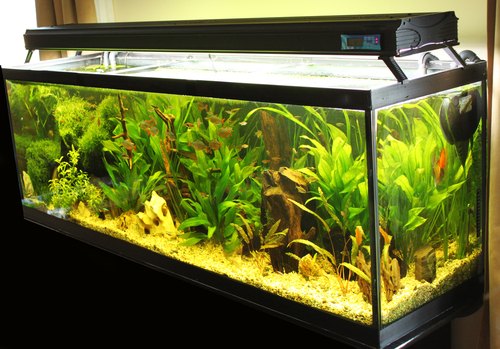
Tank setup and maintenance for a Chinese Algae Eater generally depends on what other fish you have in your intended tank. As most people don’t want to keep Chinese Algae Eaters by themselves, it’s more likely you will be introducing them to a community tank.
General Requirements
In the wild, these fish live in fast-flowing streams that have very clear water. As a result, it’s important to ensure water is kept squeaky clean with the aid of a filter that filters at least 4x the tank capacity per hour depending on what other species you have in your tank.
A HOB (hang on back) or sponge filter can work, but depending on whether other species are strong swimmers, you can also use a canister filter to ensure this cleanliness.
Author’s Note: Ideally, tank water should be changed by about a third once per week. You can do this with a specialist aquarium vacuum, just be careful to avoid your fish while you are hoovering along the bottom. This also helps get rid of any detritus your fish hasn’t eaten.
Creating A Suitable Habitat
One characteristic of this fish that is similar to other Algae Eaters is that they like to hide away when they feel threatened. Therefore, creating places within your tank where they can do this is very important.
You can do this by positioning rocks so that they form crevasses, or by buying tunnels for your fish to hide in. Some of these are available in the decoration section of any good aquatics store.
However, some aquarists put a piece of PVC piping in the tank for these fish, and other bottom-dwelling, shy Algae Eaters, to retreat into. Although it doesn’t always look very nice, your fish can love you for it, and it can easily be disguised or camouflaged with plants.
Don’t ever use sharp gravel on the bottom of a tank with a Chinese Algae Eater in it! You will find that this kind of gravel hurts the delicate stomachs of these fish.
Tankmates
Despite their reputation, the Chinese Algae Eater can work with a variety of tankmates provided there is enough space and they are fed correctly. If you fancy a less challenging Algae Eater, you may prefer the Pleco Fish, which also gets on with similar species. However, good tankmates for the Chinese Algae Eater are as follows:
- Discus Fish
- Angelfish
- Mollies
- Guppies
- Swordtails
- Platies
- Betta Fish
- Small Amazonian Cichlids
Tankmates to avoid include anything that will share territory on the bottom of the tank, such as Cory Catfish, Kuhli Loaches, and forms of Gobies and Pleco fish.
These fish can be targeted for the Chinese Algae Eater if they don’t get enough protein. This can happen when the Algae Eater tries to suck the slime coating of other fish. To prevent this, see the behavior section.
Feeding
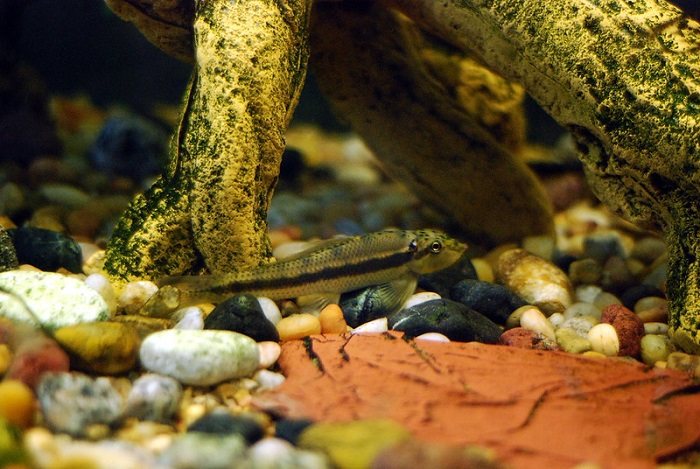
The name of this fish can be very misleading! Besides the fact they do not come from China, they actually require much more than algae to stay healthy.
At a young age, your fish will easily be able to get the required nutrients from algae wafers. However, as it grows older it will need fresh and or frozen protein like daphnia or bloodworms to balance its diet.
Chinese Algae Eaters do not often venture away from the bottom of the tank. As a result, it’s important to feed food where you can ensure that at least some of it sinks to the bottom. Otherwise, despite their larger size and comparatively feisty temperament, they can be outcompeted.
Behavior And Temperament
The Chinese Algae Eater is a peaceful fish, however, if its needs are not met, it can actually become dangerous to other fish. It needs protein as it grows and develops, and if it does not receive this, it can become predatory to other fish, although, with its sucker mouth, it can only do so much damage.
What exactly happens? If not fed sufficient protein, the Chinese Algae Eater will latch onto the slime coating of other fish and suck to get the necessary nutrients. If a Chinese Algae Eater destroys this, it can not only lead to your other fish becoming more susceptible to infection, it can be painful in itself.
Also bear in mind it is not a social, schooling, or schooling fish. It can in fact become aggressive to those of its own species.
Apart from this, you may see these guys happily sitting on the bottom of the tank, on the sides of the tank walls, and even hiding on driftwood and bits of rocks. When it comes to habitat, they do like to move around – but are generally shy, and thus you are more likely to see them tucked away somewhere. Despite their reputation, they have tons of character and are very interactive.
Is The Chinese Algae Eater Aggressive To Its Own Species?
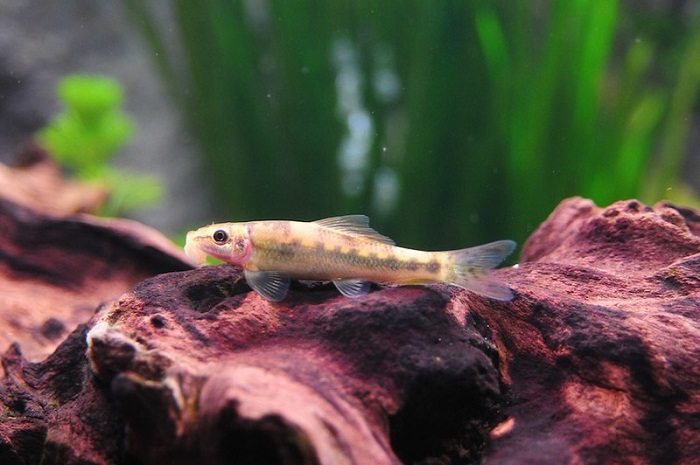
Like the Betta Fish, Chinese Algae Eaters can not get along with their own species. Unlike the Betta Fish, this CAN work in a very, very large tank (over 100 gallons/455 liters at least), but is not recommended unless you are very experienced. This is partly due to territorial issues because of the size that these fish grow.
So, long story short, they can be semi-aggressive towards their own species in general. Fish aggression is a complex topic. Often, fish just have unmet needs. However, it’s important to understand that these may include them preferring not to share territory with certain other fish. So long as you adjust your expectations, you will find no fish – the Chinese Algae Eater included – is inherently aggressive.
Pests And Diseases
Chinese Algae Eaters are sensitive fish, and they require very clear water conditions. Apart from this, however, they are prone to many of the same diseases as other freshwater species.
Bacterial Infections
Bacterial infections result from poor water quality, and Chinese Algae Eaters can be more prone to them than most due to the crystal clear conditions they live in in the wild. Thus, they are very sensitive to dirty water.
If you see your water become cloudy, it’s a sure sign you need to change it more frequently or invest in a stronger filter. However, including plants can also help filter nitrates and other toxins.
If you see dark patches or ragged, sore patches appear on your fish, especially around the fins or mouth, this is a sign of a bacterial infection such as fin rot. You can treat this by isolating the fish and offering an over-the-counter antibacterial medication from your local aquatics store.
Fungal Infections
One common risk with any algae-eating fish is the infection of your fish’s sucking mouth. Be very careful if you see any white growths surrounding your fish’s mouth. A fungal infection can be painful, prevent your fish from feeding, and can spread to other parts of its body. In extreme cases, it can even cause haemorrhaging.
To treat this, it’s good to remove the fish to a separate tank and treat it with a saltwater bath until the fungal infection goes away.
Parasitic Infections
Parasitic infections such as Hexamita or hole-in-head disease also result from unclean water but manifest differently. Parasites can weaken your fish’s immune system and make them more susceptible to other infections.
As they are not bacterial, you cannot treat them with antibiotics. Instead, a saltwater bath is the best option. Other parasitic infections include ich, and velvet, or ‘gold dust’ disease.
What To Do If Another Fish Gets Attacked By A Chinese Algae Eater
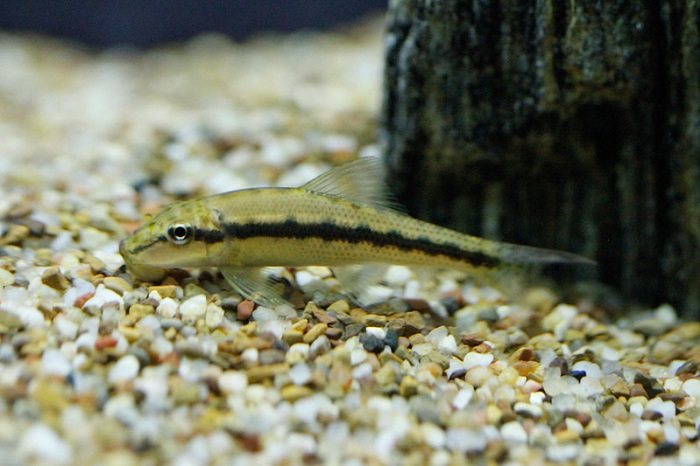
If your Chinese Algae Eater attacks another fish to suck the slime coating you may worry that your other fish can get infected. This generally happens to slow-moving fish that hang in one place in the water such as discus fish. It is especially important to prevent because the mouth of the Chinese Algae Eater is lined with small hooks that can do a lot of damage.
If it happens, it’s best to be on the safe side and transfer the injured fish to another tank, possibly using a saltwater bath to prevent the growth of the disease.
If possible, it’s also a good idea to isolate the Chinese Algae Eater in case they do this to other fish. This kind of behavior is a sign your Chinese Algae Eater doesn’t have its dietary needs met.
In fact, it’s a firm indication that you need to raise the amount of protein in your fish’s diet. At this point, it can then be safe to add the Chinese Algae Eater back to your main tank.
Author’s Note: If you don’t have enough space, you may find you have to decide between isolating the Algae Eater, or the injured fish. In this instance, it’s best to factor in the severity of the injury, and how aggressive your Algae Eater seems. Try feeding more protein for a few days to determine how easily you can fix this behavior.
Breeding
In keeping with their mixed reputation in terms of behavior, not that much is known about the breeding habits of these fish.
There are anecdotal reports of them spawning in mixed community tanks, especially when fishkeepers don’t pay that much attention. However, it’s very hard to get them to breed deliberately. One of the biggest challenges is the difficulty in sexing them, and the aggression towards their own kind.
However, some of these fish are bred commercially on fish farms. They are in fact eaten in some of the countries where they come from. This naturally relies on breeding, but in general, it involves the addition of hormones and thus is not achievable by the home fishkeeper.
Final Thoughts
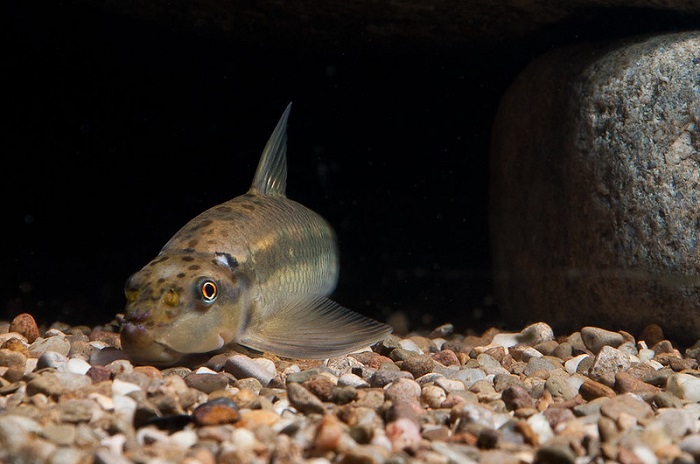
Chinese Algae Eaters have gained a reputation for being difficult, and this is sometimes not without reason. But generally, this stems from them not having their needs understood correctly.
If you are prepared for a slightly more challenging fish and are willing to put in the effort to learn about their unique requirements, they can make an unusual and rewarding tankmate that can bring a back-to-nature look to your aquarium.


